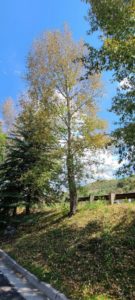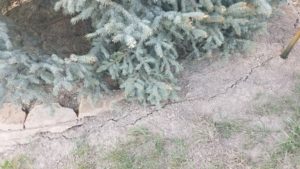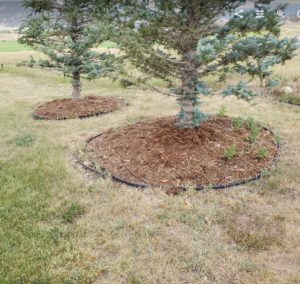Hot and dry. Here in Eagle County we can add hot and dry to the challenges we face during the summer of 2020. COVID-19 has forced us all to spend more time where we live and many homeowners are taking advantage of the opportunity to undertake home improvement projects both inside and out.
Here in the Old Growth office, we receive several phone calls each day about sad trees suffering as a result of prolonged drought and increasingly higher temperatures.
In the field, we are seeing needle drop on the spruce trees, shriveled leaves on the aspens, and many other indicators of overall stress in all species of plants. This stress also provides opportunities for pests and parasites to invade, which compounds damage from drought.

Image: Drought Stressed Cottonwood with crinkled leaves that are falling too early in the summer months.
What we can’t see, however, is a detrimental lack of soil moisture that persists despite our attempts to water now when we think our trees need it most.
Soil moisture is the water held in the spaces between the soil particles. Surface soil moisture (what we see when we water) exists in the upper 10 cm of the soil, whereas root zone soil moisture is the water available to the plants and that is found in depths up to 200 cm below the soil’s surface.1 This 200 cm of soil builds and loses moisture over time, and cannot be sustained by the small bits of rain that we have received this summer.

Image: With soil moisture lacking at the top of the surface it is a good indicator that the root zone moisture is surely lacking.
In addition to the hot and dry summers we’ve been experiencing, winter snow totals in the last several years haven’t been enough to compensate. To make matters worse, projected warming will increase the rate at which soil moisture is lost during dry spells, increasing the intensity of future, naturally occurring droughts.4
The soil moisture content calculated as recently as June of 2020 shows Colorado to be within only 10-20% of calculated soil moisture.5 You can see a graph of soil moisture percentages throughout the country by clicking HERE.
According to weather.com, our average precipitation by month is 1.92 inches.3 However, this is an average from a few decades of unprecedented drought, so this average doesn’t reflect the total precipitation that our trees really need.
According to the Community Collaborative Rain, Hail & Snow Network, here are our precipitation totals recorded so far in 2020:2
- Jan 2020 – 2.24”
- Feb 2020 – 2.99”
- Mar 2020 – .95”
- April 2020 – 1.64”
Long story short: not enough rain this year; not enough rain last year; not enough moisture in the last 10 years; and not enough expected in the next year.
Solutions: There are several but consider all of them together as a comprehensive approach to saving your trees.
1) Irrigation is key. Not just in the dry months, but consistent irrigation to saturate the soil all the way down into the root zone. Ideally, we always want to be feeding that base of moisture. Most importantly, consider the shoulder months when there isn’t snow, but it is too cold for your irrigation system to be running. During these times, your trees still need moisture, and while they might not show outward signs of stress, the deficit in soil moisture is getting increasingly larger and reaching an inflection point from which snowmelt or irrigation can’t catch up.
2) Add a hardwood mulch ring around the trees. This can cool the soil in the summer, which will help retain moisture. Since our soil in Colorado isn’t ideal, the hardwood mulch can also add organic material that will improve the soil around the tree. Reminder: keep the mulch to a minimum so that it doesn’t form a ring at the base of the tree and suffocate it. The hardwood mulch can also lessen competition from grasses that grow beneath the trees and rob the soil of moisture.

3) Fertilize. Depending on the type of tree, there are several ways to add nutrients that can help the tree hold moisture. For example, adding potassium to certain trees can help it hold onto the water and use it more efficiently.
Think of it as Gatorade for your trees!
Video: At Old Growth we can use an injection wand to provide your trees with the necessary water and fertilizer they need to thrive. This give us a chance to get below the surface and push the water down into the root zone responsibly adding what the tree needs.
